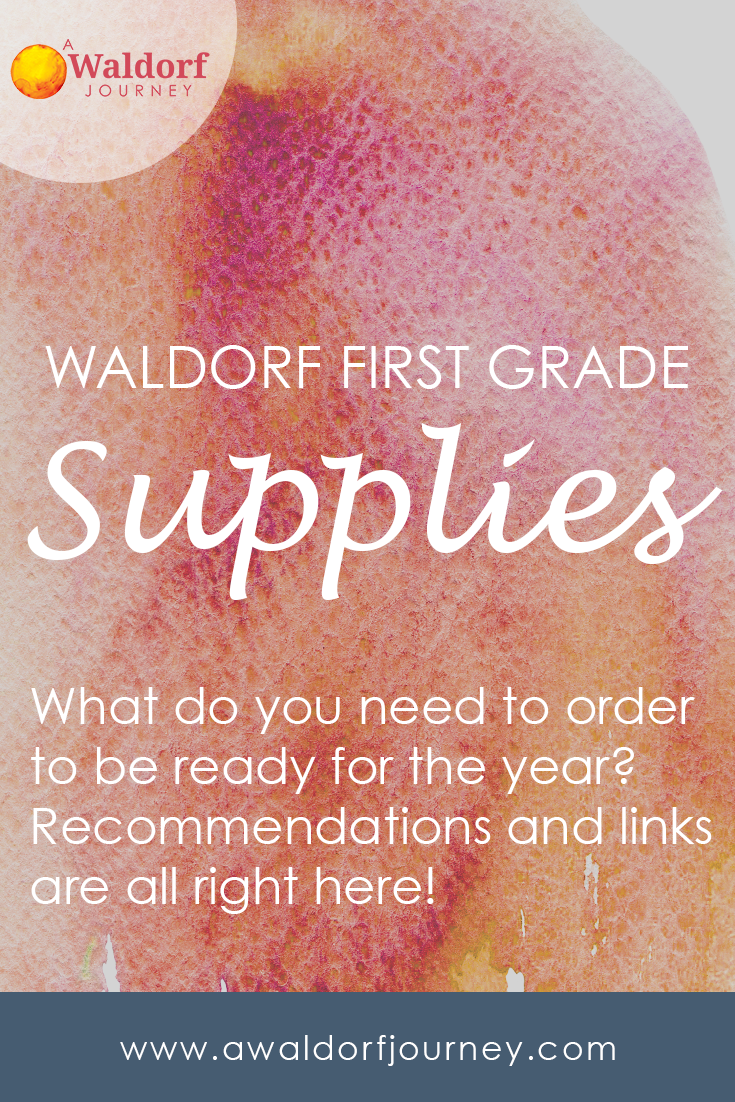 I recently recorded a podcast all about ordering supplies, but I finally placed my order for Waldorf first grade supplies this week, so I thought I would share everything that I ordered.
I recently recorded a podcast all about ordering supplies, but I finally placed my order for Waldorf first grade supplies this week, so I thought I would share everything that I ordered.
While most of my supplies were ordered from Mercurius, a lot of the materials can be found on Amazon. I’ve linked over to Amazon where possible. The links are Amazon affiliate links, so if you click over and order a few pennies land in my pocket (at no cost to you.) Thanks for supporting the blog and podcast!
So, with that out of the way, here’s my Waldorf first grade supplies list.
General
Mercurius main lesson books, 32X38 cm, without onion skin. I ordered 5 sets of books to keep us going all through the year.
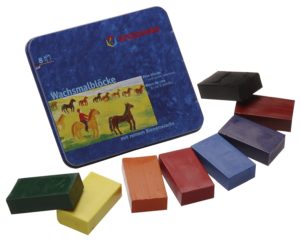 Stockmar Crayons, 8 blocks, 8 sticks — I don’t imagine I will start out by giving the students their own crayon sets. I will probably keep all of the crayons in baskets sorted by color at first and we’ll hand them out when needed. Because we’re starting the year with a moveable classroom, the students won’t have their own desks for storage anyway.
Stockmar Crayons, 8 blocks, 8 sticks — I don’t imagine I will start out by giving the students their own crayon sets. I will probably keep all of the crayons in baskets sorted by color at first and we’ll hand them out when needed. Because we’re starting the year with a moveable classroom, the students won’t have their own desks for storage anyway.
Lyra Super Ferby Coloured Pencils in prussian blue, red, magenta and viridian. These are used for writing only, so they won’t need a full set yet. I prefer the unlacquered, but my colleague likes the lacquered ones for preventing confusion.
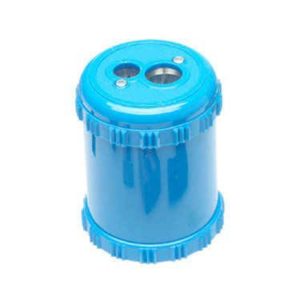 Dual Sharpener for Pencils — I ordered 6 that I will keep in my desk to sharpen pencils as needed.
Dual Sharpener for Pencils — I ordered 6 that I will keep in my desk to sharpen pencils as needed.
Mercurius Blackboard Pastel Chalk — Though I’m a huge fan of Prang Ambrite chalk for general use, and Quartet Alpha Low Dust White Chalk, there are certain colors of Mercurius that are worth having. I bought individual color boxes that will last me for a few years.
Drawing paper — 32.5X44 cm, 500 sheets, medium heavy weight. We’ll see how far this gets us, but I expect that I’ll need to order more.
Painting
Fabriano Watercolour Paper, white 35×50, 20 50-sheet packages (I’ve linked to a Fabriano pad on Amazon. It looks similar to the paper I ordered on Mercurius.)– I splurged on painting paper. The younger the student, the more important quality paper becomes. Those little ones can really overwork the paper and make it pill if it isn’t good quality.
Stockmar Watercolor Paint in ultramarine, carmine red, prussian blue and lemon yellow — I happen to have a lot of paint leftover from my current class, but I figured I’ll need more of the basic colors.
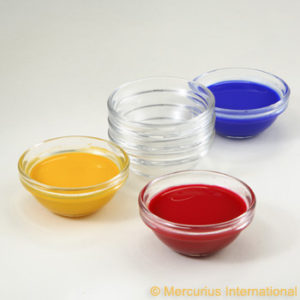 Paint Jars without lids — I’m really excited to try this method. Paint will not be stored from week to week (they tend to muddy the colors anyway.) Instead I’ll keep jars of colors and refill each week as part of the painting set-up.
Paint Jars without lids — I’m really excited to try this method. Paint will not be stored from week to week (they tend to muddy the colors anyway.) Instead I’ll keep jars of colors and refill each week as part of the painting set-up.
Wooden holders for 3 glass paint jars — I ordered one for every two students. I may order more, but I think it’s okay for them to share paints.
Extras
Stockmar Modeling Beeswax — I ordered lots of modeling beeswax and I’m so excited to do beeswax with my students! This is a subject that is totally new to me! I ordered a variety of colors, with a whole lot of extra natural and pink — I love those shades of the Stockmar beeswax.
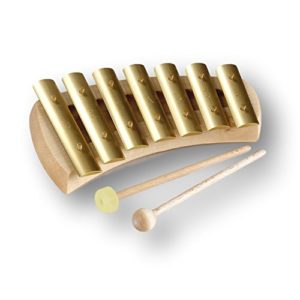 Auris Pentatonic Glockenspiel — I had one of these when my kids were little but I passed it along. I’ll be glad to have it again!
Auris Pentatonic Glockenspiel — I had one of these when my kids were little but I passed it along. I’ll be glad to have it again!
After going through this process I am so excited to teach first grade! I’m already thinking about nature tables, gentle transition cues and fun little family stories!
Let me know if you’ve found this list helpful, or if there’s anything else you think I should add. Bear in mind I’m ordering for a very full class of nearly 30 students. Your quantities may vary.




In my kindergarten and grade one classroom we use old pump soap bottles for our acrylic paint. The students grab a tray and take one squirt of the colour they want. They only have the primary colours, black and white. We use plasticine or sticky tac on the ends of the pumps so they don’t dry out.
My students have been doing so much more painting since I introduced them. My mind is also more at ease about not wasting paint. And there’s a lot less muddy paints!
I love this idea! Watercolor painting with 30 first graders is going to be a challenge so I’m looking for ways for them to take responsibility for some of the set-up. I’m a little worried about paint going everywhere, but I guess they’ll never learn to manage it unless I give them the chance. Using pumper bottles is a great way to make it simple! Thanks!
I use recycled ketchup bottles with the watercolours – no mess with the little bowls and I don’t have the wooden holders yet. One child per colour goes around and gives out paint. I haven’t had a spill all year! (knock on wood) I also used screw top small mason jars to make some “dry watercolours” because we’ve been trying out Eugene Schwartz’s patient painting then kids can paint outside painting class. they only need to get some water
This is great. And I love letting kids paint outside painting class. A few of my 8th graders help themselves to the painting stuff all the time. They’ve got watercolored main lesson pages — just beautiful! I love it!
I’ve been shopping for pretty bottles to store paint but recycled ketchup bottles seem so much more convenient. And tidy! And cheap!
Thank you for the list. I noticed you said you will be doing a movable classroom next year. I would love to see a post on why and how you will be doing this.
I am doing movable classroom next year. My plan is to do a full post about it — once I learn a little more. It will be a completely new experience for me and I’m more than a little worried about it. There are some strong opinions about movable classroom among the faculty at my school. I’m hoping to make the best of the advantages and minimize the drawbacks. But yes, I will be doing a full post about it.
Can you talk a bit about main lesson book size? (I teach 2-3 btw and had them using 32×24 landscape format but after an observation I was told grade ones should use the 32×48 size 23×38 for grade 2 and 3. I found as soon as my children transitioned to cursive they couldn’t balance their writing well on the large page
Yes. I’ve been told to get the 32×38. It makes sense to me to get the smaller books in 2nd and 3rd. And then the even smaller ones in 4th and 5th. One year in 6th I tried going back to the larger books (their handwriting was getting so small I thought a large page would encourage them to write larger.) It worked pretty well and it was challenging for them to fill the page with creative content. I didn’t do it with this group, though. I really like switching to loose paper and binding individual books starting in 6th grade.
I gave my first class crayon rolls midway through first grade and wished I had stayed with the baskets of crayons. I was excited to find these wooden crayon holders and am giving my new class an 8 block/8 stick holder. With a bulk discount, they were cheaper than crayon pouches and will allow the students to take good care of their crayons! They are also beautifully made and the people who run the shop are lovely.
https://www.etsy.com/listing/285474883/wooden-crayon-holder-for-beeswax-blocks?ref=shop_home_active_35
So glad to read this! My inclination is to keep the community crayon basket going for as long as possible. I switched to individual paintbrushes when the students who cared for their materials got frustrated with the ones who didn’t. In retrospect I think it would have been better to just teach them all to take care of things! I’ll definitely take a look at those wooden holders!